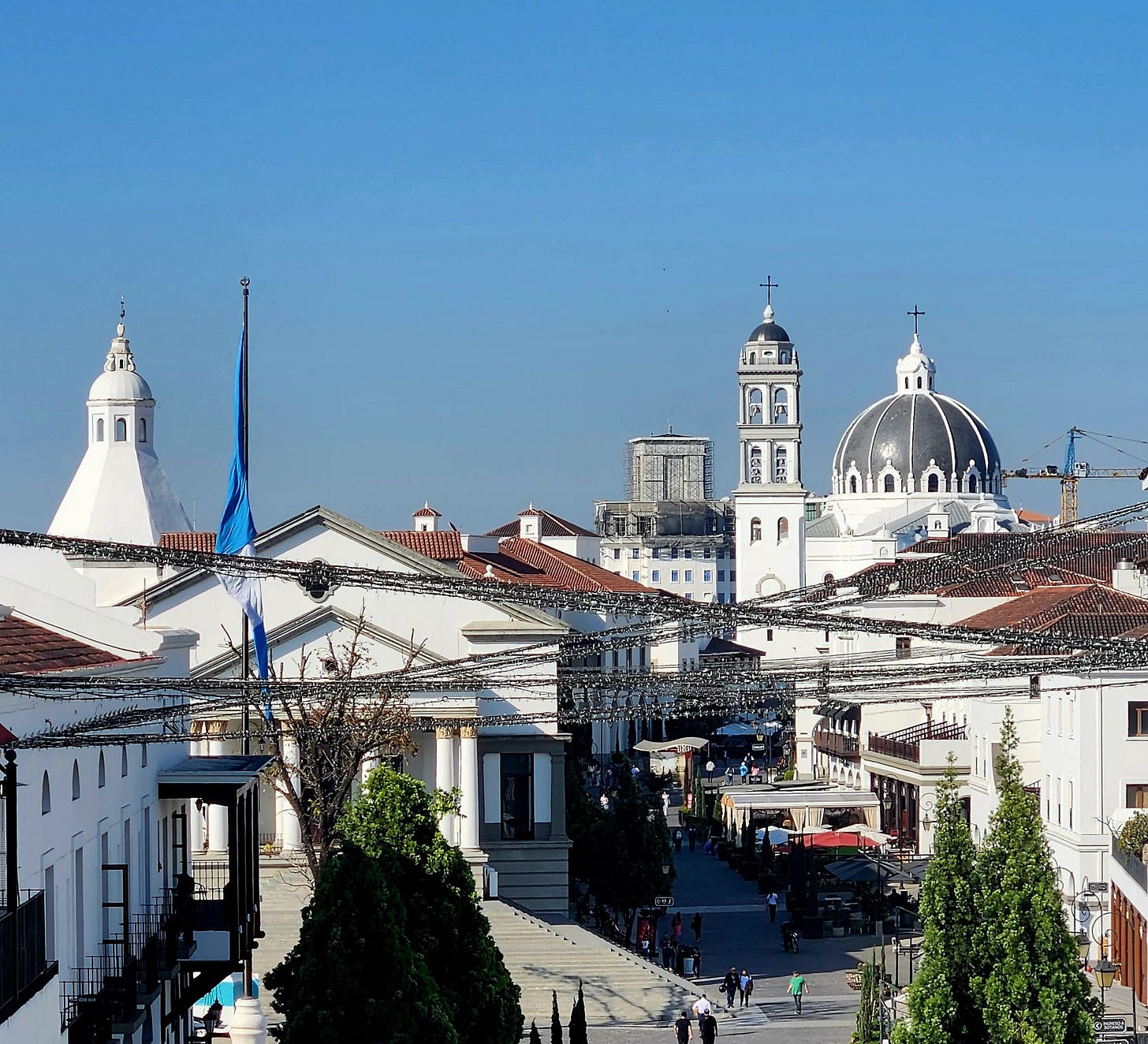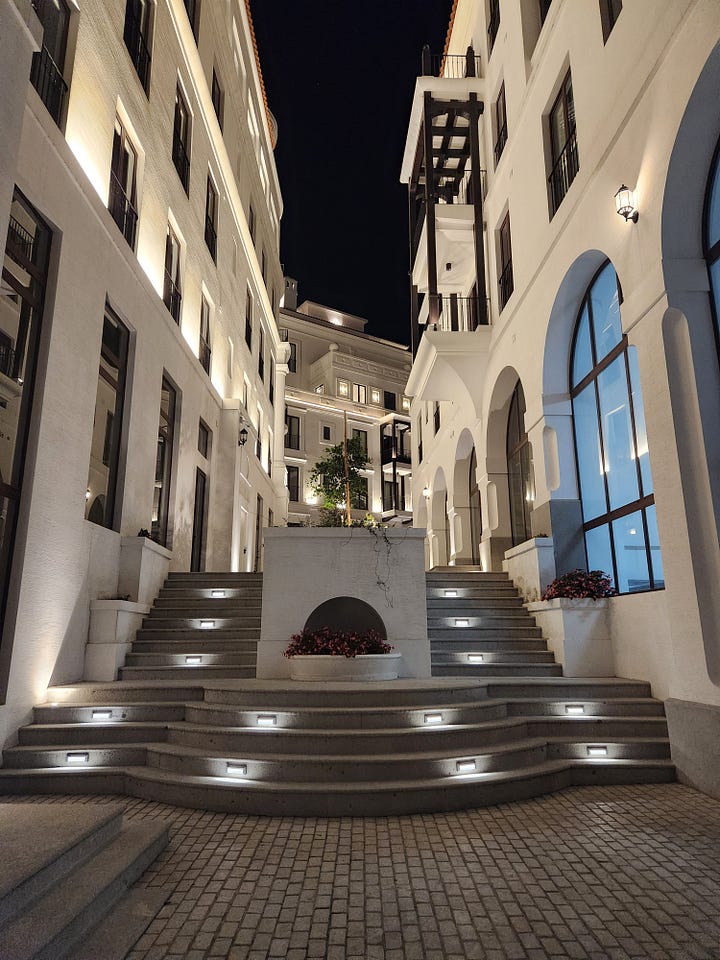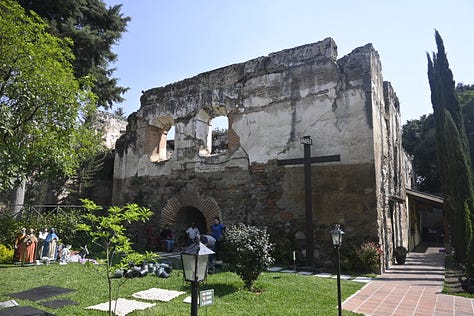A Tale of Two Cities: Cayalá and Antigua, Guatemala
What can Guatemalan cities teach about urban design in the South?
Charles Dickens might have had London and Paris in mind when he wrote about the best and worst of times, but Guatemala presents a modern tale of two cities that encapsulate a similar duality. Cayalá and Antigua serve as the backdrop for a narrative about urban beauty—one city champions a polished, unblemished ideal, while the other embraces what the French call joie-laide, or beauty in imperfection, history, and lived-in charm.
Ciudad Cayalá is the newest neighborhood in a congested and gritty Guatemala City. It represents a modern, New Urbanist community designed as a self-contained, walkable borough that integrates residential areas, retail, offices, and recreational facilities within a single, harmonious setting. The neighborhood features a neoclassical architectural style, with buildings and structures that project a sense of order, symmetry, and traditional beauty, with the slightest, subtle nod to Guatemala's Mayan heritage. Despite its beauty and the quality of life it promotes, Cayalá, which means Paradise in Cakchiquel, the language of Guatemala’s Maya highlands, has faced criticism and controversy. Some view it as an enclave of exclusivity and privilege in a country that struggles with significant inequality and poverty.
Exclusivity vs. Authenticity
At the Paseo Cayalá shopping district, cars enter through one entrance and go straight to an underground parking lot. The pedestrian marketplace above resembles in scale the grand Maya plazas called Naab, which means lagoon, since the Maya plazas also doubled as rainwater catchments. However, in ancient times, the large open spaces in Guatemala were surrounded by temples and palaces and served as the epicenter of civilization, large enough to hold the entire population, hosting rituals, festivals, and a central market.
The splendid, white-walled boutiques and restaurants surrounding the square at Paseo Cayalá are not a central market for bargain shoppers. Brands like Ferrari, Porsche, Arturo Calle, and Antony Morato are just some of the 30 stores within the development. The development also offers a park, two hotels, a bowling alley, batting cages, tennis courts, a zip line, a surf park, and 650 gated residences.
Cayalá is a marvel of modern, classical architecture. The development appears to have been established during the Spanish colonial era and then impeccably preserved. Its stone pavement, red-tiled roofs, and white stucco walls, ornamented with intricate carvings, tile work, and wrought iron details, reflect the finest regional craftsmanship. A Greek-style temple serves as a community center. A nod to Mayan culture, the building is set on a platform atop a giant stairway. The structure is characterized by stately columns, each crowned with capitals that, rather than the acanthus leaves of the Corinthian order, bear the motif of maize—a nod to the local flora and a symbol of fertility and prosperity.
The Mayans used wide stairways at plazas as stages for religious events, presentations, and dances. Customers leave the underground parking at Calyalá, ascending on luxurious escalators designed after the art nouveau Parisian Metro stations. The development was promoted as a welcoming place, open to all citizens. Still, unlike the rest of Guatemala City, crowded and vibrant, only a few tourists were milling about when we visited. Security guards in suits and small earpieces quietly monitored the area. Despite developer aspirations to welcome all Guatemalans, the reality paints a different picture: retail spaces mirror those found in upscale American malls, replete with international labels. The rent for a modest apartment in this area, standing at $1,300, starkly overshadows the average monthly income in Guatemala, which hovers around $579. Critics rightly argue that while Cayalá offers a sustainable and well-planned urban development model, it is a sterile place inaccessible to most of Guatemala's population.
Cayalá stands as a beacon of controlled design. It inadvertently sets the stage for a profound contrast with the rich historical tapestry and vibrant life found elsewhere in Guatemala. The difference becomes particularly striking when one turns their attention to the storied streets of Antigua, Guatemala. This transition from the polished, exclusive corridors of Cayalá to the lively, spontaneous environment of Antigua marks a journey not just between places but between contrasting philosophies of urban living and community.
At the same time, houses in Antigua are more expensive than those in Cayalá, costing millions of dollars, yet the picturesque, historical city faces no social criticism. As a city that developed organically over time and was reconstructed on the whims of many generations, Antigua does not feel like a perfect imposition on Guatemala but rather its finest expression. Antigua has the advantage of authenticity.

The Streets of Antigua Guatemala
Urban authenticity stems from a place's genuine raison d'être, evolving naturally over time. It's a quality nearly impossible to replicate in new developments, even with the involvement of renowned designers like León Krier and his acclaimed Estudio Urbano. Striving for design perfection renders a place complete, crippling its gradual evolution—a process shaped by its residents over time rather than dictated by external experts.
To wit, not all of Antigua is beautiful. The streets are jammed with traffic. Walking its sidewalks requires constant attention to trip hazards. Some buildings are rundown. Yet Antigua is the kind of place you can spend a lifetime. Where life can unfold at its own pace—a place not solely sought after for its sophistication or the status it symbolizes despite its exclusivity. It embraces the visitor with a sense of belonging rather than awe. It's a city where the essence of humanity is palpable, where the marketplaces become melting pots of diversity, bridging the gap between the affluent and the less fortunate without a hint of distrust or fear.
The city's charm is encapsulated in its low-rise silhouettes, the rustic allure of its cobbled pathways, and the majestic beauty of its churches, standing as silent witnesses to centuries of history. Founded in the early 16th century as Santiago de los Caballeros de Guatemala, Antigua was the heart of a Kingdom spanning much of Central America. Its rich past is preserved in the Spanish colonial architecture that paints the streetscape, while some majestic and haunting ruins narrate the story of earthquakes and generations of reconstruction.
Antigua is not merely a backdrop to history; it is a living, breathing testament to the Guatemalan people. It offers a window into the past and an invitation to be part of a continuing story. Vibrant cultural celebrations draw Guatemalans from all over the country to visit, especially during Holy Week or Semana Santa. During this period, the city transforms, eschewing vehicles to make way for religious processions, stunning flower carpets, and a festive atmosphere that engulfs the city. Although international tourism forms the economic backbone of Antigua, it's noteworthy that most of its visitors are from within Guatemala. This fact underscores Antigua's role as a cultural epicenter for the Guatemalan people, cherished for its profound cultural significance rather than merely architectural marvels. The city is an authentic gem, akin to a natural diamond compared to cubic zirconia, radiating cultural richness rather than architectural virtuosity. The high cost of living that might preclude many Guatemalans from residing in Antigua does not detract from its genuineness. Instead, it underscores the city's unique allure and deep-rooted cultural significance, making it a cherished landmark that transcends mere aesthetics. Singular, modern design objectives did not guide the city. The humanity of its population guided it.
Cayalá hasn't become the bustling hub envisioned, particularly for an entertainment landmark in South America, where energetic crowds are a staple. In contrast to the lively atmospheres of even modest shopping centers in Guatemala City, Cayalá presents a reserved, perhaps even sterile, ambiance. Cayalá's aspirations to redefine urban living with haut design and a nod at inclusivity may fall short. Striving for perfect architectural harmony may be the defect. Antigua's organic evolution, enriched by the lives and stories of those who have walked its streets, contrasts with the more curated experience Cayalá offers, underscoring the difficulty of creating new urban spaces that aim to use aesthetic refinement to achieve sociability. These hyper-refined developments appeal to architects, not necessarily to the public.
Antigua, Guatemala is a testament to the beauty and depth that can emerge from the organic, often chaotic process of historical evolution. Its cobblestoned streets, baroque architecture, and vibrant, genuinely public squares do not conform to a singular vision of perfection but rather embrace the layers of history, culture, and human endeavor that have shaped them. This embrace of imperfection, of the authentic and the lived-in, lends Antigua a strength and vitality that a meticulously planned environment like Cayalá may never obtain.
Redefining Southern Urbanism: Lessons from the Far South Cayalá and Antigua
This contrast between Cayalá and Antigua is a powerful illustration of the principles that should guide the creation of new communities, particularly in the Southern United States, a region celebrated for its hospitality and rich history of ethnic and economic diversity. As developers and urban planners, the contrasts between Cayalá and Antigua are a cautionary tale when we create new places within this vibrant context, underscoring the paramount importance of designing communities that do not only prioritize aesthetics and exclusivity but earnestly embrace the rugged inclusivity and chaotic vitality that are hallmarks of beloved, traditional urban centers. Cities must provide affordable housing, lightly regulate street vendors, and allow just enough disorder to make streets feel real.
With its famed ethos of warmth and charm, the South presents a unique opportunity to redefine modern communities. The challenge lies in ensuring these new developments are integrated spaces that celebrate the diverse cultures, histories, and economic backgrounds of their inhabitants. To ignore this is to risk creating spaces that, while beautiful, lack the soul and vibrant communal life intrinsic to the Southern way of living.
In crafting the future of Southern urban development, Cayalá and Antigua remind us that true community is nurtured through spaces that foster a shared sense of belonging. The hospitality and élan associated with Southern living are not just products of place but of people coming together in those places.
By weaving Southern hospitality into the fabric of our neighborhoods, we create vibrant testaments to an inclusive and welcoming spirit, a hallmark of this cherished region.














Fernando Pagés Ruiz builds nonsubsidized affordable homes for a largely immigrant community. He collaborates with DPZ CoDesign on cost reduction, chairs CNU Latino, and writes for Fine Homebuilding and the Green Building Advisor. The second edition of his bestseller, “Building an Affordable House,” with The Taunton Press, is now available





